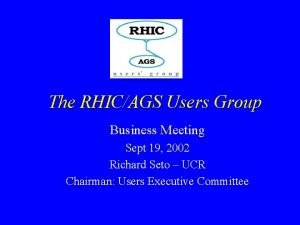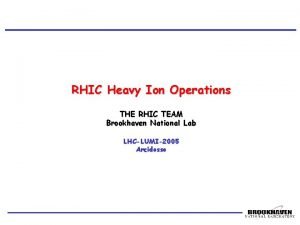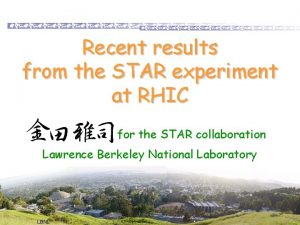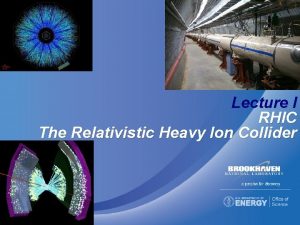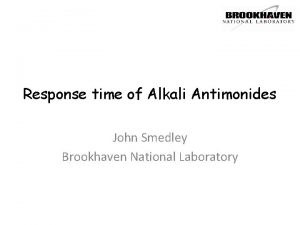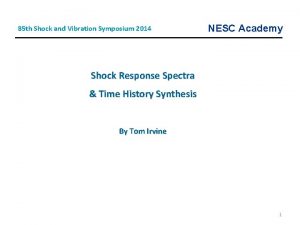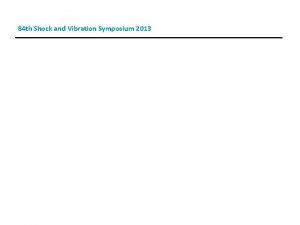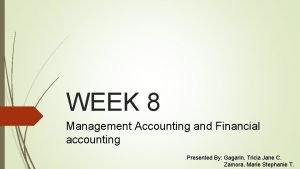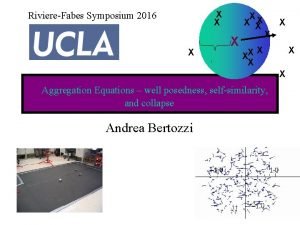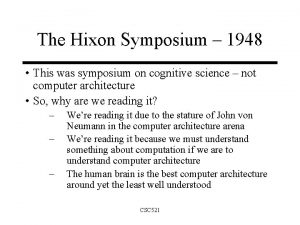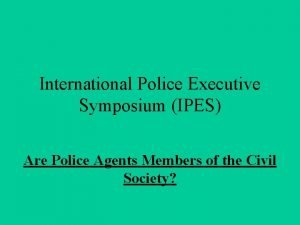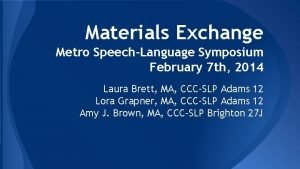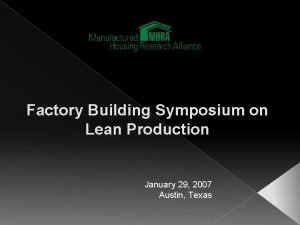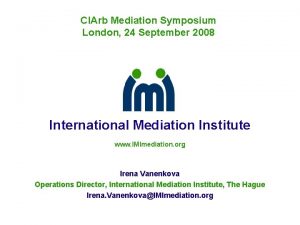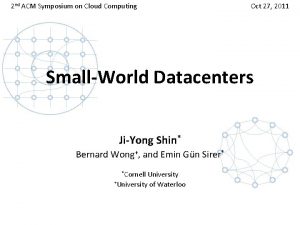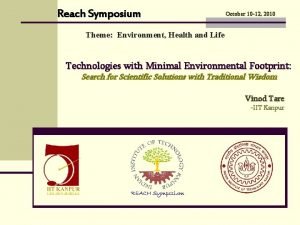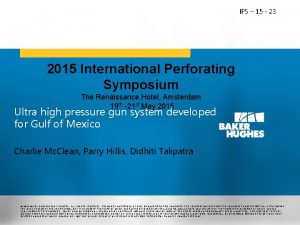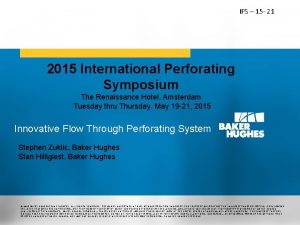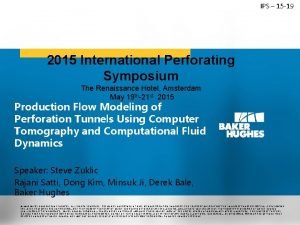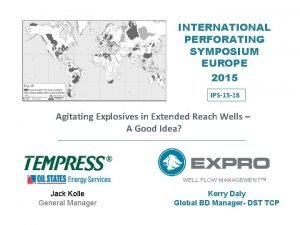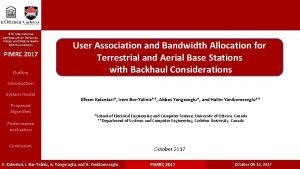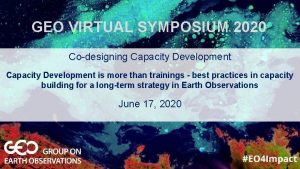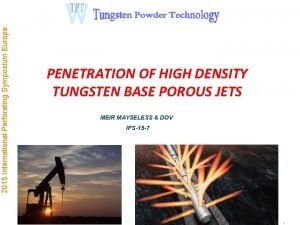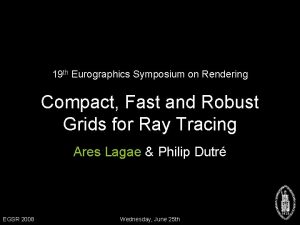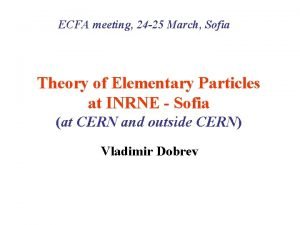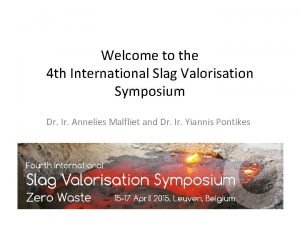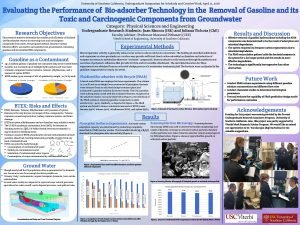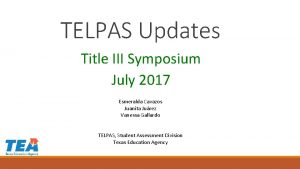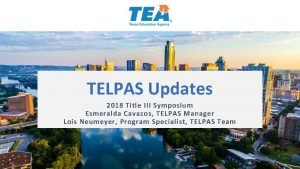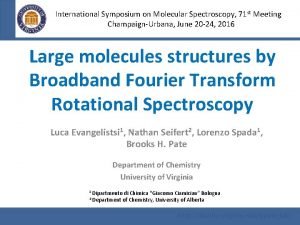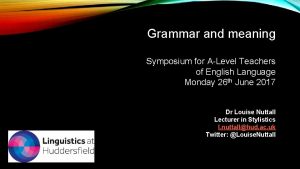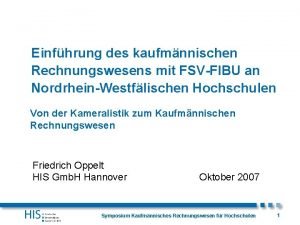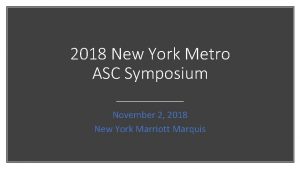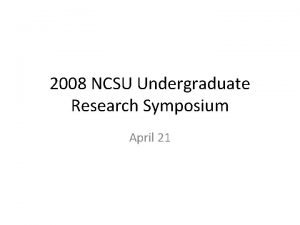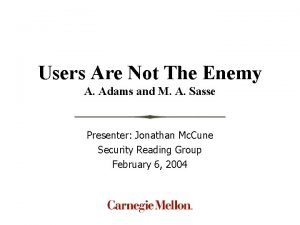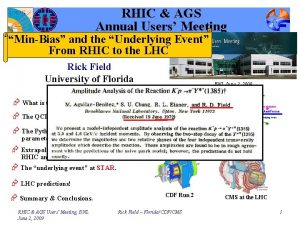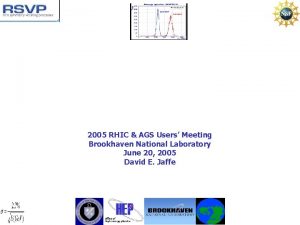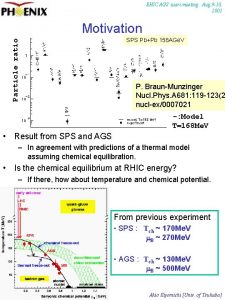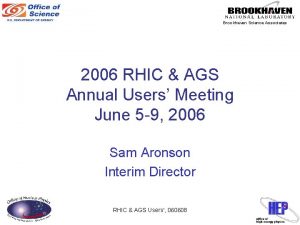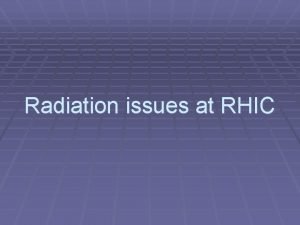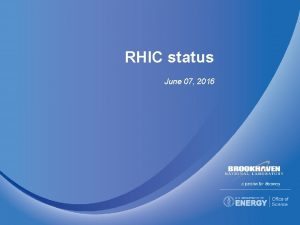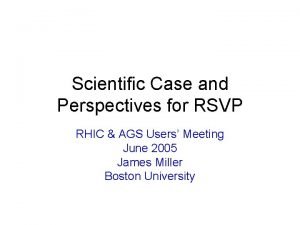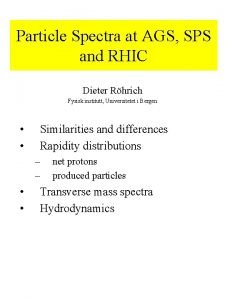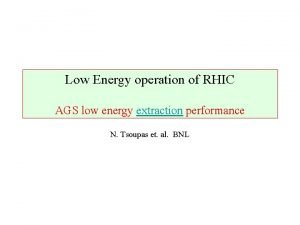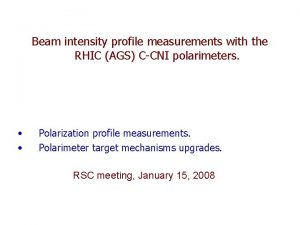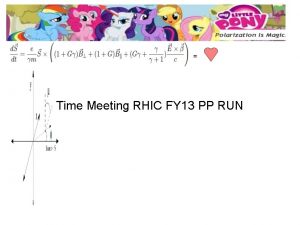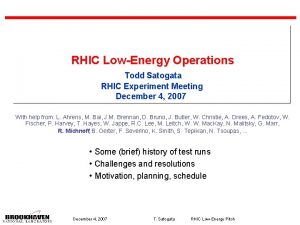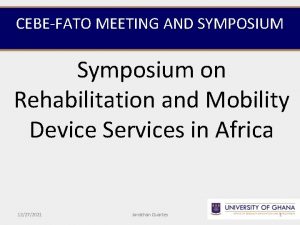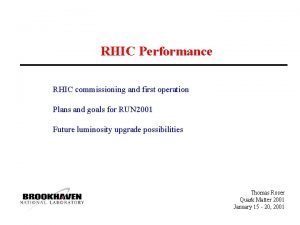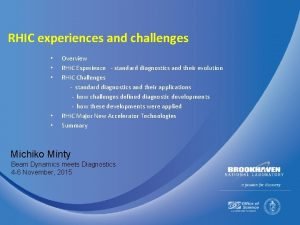Special Symposium on RHIC and AGS Users Meeting





























































- Slides: 61

Special Symposium on RHIC and AGS Users Meeting 28 May 2008 RHIC Spin—Where did it come from? --a fable with a moral G. Bunce with help from Mike Tannenbaum, Nick Samios, Yousef Makdisi, Hiromi Okada, Haixin Huang, and more

many interweaved threads: --accelerating and measuring polarized protons --large spin effects at high energy --unexpected and expected --the W --the polarized DIS story and the proton spin “crisis” --perturbative description of p-p collisions --and many other theoretical advances --making the case and getting support

The 1970 s…

Accelerating and measuring polarized protons… --the problem and solution is the very large anomalous magnetic moment of the proton (and the large proton anomalous magnetic moment is the basis of RHIC Spin, and RHIC polarimetry) The problem of spin resonances: • Spin precesses about guide field (proton: 200 precessions in one turn at RHIC, 100 Ge. V) • Spin precesses about horizontal magnetic fields (for example, focusing fields) • When the 2 precessions beat, resonance condition: every 500 Me. V of acceleration!

Polarization Measurement on AGS Ramp Spin reverses at every spin resonance. 5 AGS 2005 (with snakes) 16 23 Ge. V

Solution (1973): Siberian Snakes Polarization kinematics of particles in storage rings. Ya. S. Derbenev, A. M. Kondratenko (Novosibirsk, IYF). Jun 1973. 6 pp. Published in Sov. Phys. JETP 37: 968 -973, 1973, Zh. Eksp. Teor. Fiz. 64: 1918 -1929, 1973. TOPCITE = 50+ Cited 67 times Spin resonance: spin axis is no longer vertical Snake: precess spin 180 degrees about axis in horizontal plane. Two orthogonal snakes: flip non-vertical component of spin each turn. Spin unwinds away from vertical in one turn, and winds back to vertical in the next turn. Spin resonance does not build up.

1970 s: Development of polarized proton acceleration in 12 Ge. V ZGS --weak focusing machine Acceleration of Polarized Protons to 8. 5 -Ge. V/c. T. Khoe, et al. (Argonne) , A. D. Krisch, J. B. Roberts (Michigan U. ) , J. R. O'Fallon (St. Louis U. ). Print-74 -0985, (Received May 1974). note: no siberian snakes

NIM 1979: describes development of PEGGY --started in late 1950 s

PRL 1978: first measurement of proton spin structure e + p e’ + X

For hadronic scattering… --spin effects expected to die out at high energy, and hard scattering --but two surprises --actually 3 surprises…

p + p Lambda + X (Fermilab) PRL 1976 p + p (ZGS) PRL 1978

Also at ZGS: Inclusive pion production p + p pi + X Phys. Rev. D. 18 (1978) 3939 -3945

W-4

Parity violating W Production Unpol. q-g q-q p + p jet p + p dijet

p+p e + Drell. Yan

1979: EMC – 9

1980 s…



m_W = 80 Ge. V? 1982: W – 1


p + p 2 jets m_W (? ) …simulation of parity-violating subtraction

EMC - 6

Physics Letters B 122, 24 February 1983, Pages 103 -116: Experimental observation of isolated large transverse energy electrons with associated missing energy at root(s)=540 Ge. V UA 1 Collaboration, CERN, G. Arnison, et al. We report the results of two searches made on data recorded at the CERN SPS Proton-Antiproton Collider: one for isolated large -ET electrons, the other for large-ET neutrinos using the technique of missing transverse energy. Both searches converge to the same events, which have the signature of a twobody decay of a particle of mass 80 Ge. V/c. The topology as well as the number of events fits well the hypothesis that they are produced by the process pbar + p W^+/- + X, with W^+/- →e^+/- + ν; where W^+/- is the Intermediate Vector Boson postulated by the unified theory of weak and electromagnetic interactions.

Fast forward a few years… ---demise of Isabelle 1983 ---development of RHIC proposal for heavy ion physics soon after ---polarized proton program at AGS mid 80 s ---EMC: deep inelastic scattering of high energy polarized muons with a polarized proton target: (q + qbar) carry little of the proton spin!— 1988/9

PRD 1989: summarized development of p in AGS A tour de force: the AGS is a strong focusing machine. about 40 of these to reach 22 Ge. V…

EMC at CERN: J. Ashman et al. , NPB 328, 1 (1989): polarized muons probing polarized protons “proton spin crisis”

DIS highpp TT pp

PRL 1989: siberian snake test at IUCF

1990 s…

Late 1980 s-1990: Polarized protons at Fermilab p + p Lambda + X p + X , p + p pi + X ZGS (12 Ge. V/c) Phys. Rev. D. 18 (1978) 3939 -3945 Fermilab (200 Ge. V/c) Phys. Lett. B 261(1991)201 Phys. Lett. B 264(1991)462

1990: Polarized Collider Workshop at Penn State: What else carries the proton spin ? How are gluons polarized ? How large are parton orbital angular mom. ? 1993: proposal to collide polarized protons in RHIC

PRL 1994: partial siberian snake in AGS

Also in 1994 PRL: ad for RHIC spin

Some important “politics”: --1990: Argonne joins RHIC spin program --Nov. 1990: Penn State workshop, RHIC Spin starts --RHIC spin supported by PAC 1993 --1994: RIKEN/BNL collaboration toward snakes --1995: external review supports RHIC Spin --1995: signing of BNL-RIKEN agreement --RBRC starts in 1997 --1998: DOE Nuclear Physics includes RHIC Spin as part of the RHIC program --DOE and NSF support—spin groups and apparatus --2006: Renaissance Technology support of first long spin run

1996 -2001: Siberian Snakes 2003 -4: Warm AGS Snake: precess spin, leaving beam direction unchanged at exit of snake

Many theory advances: Longitudinal: (DIS: 1978, W: 1983, EMC: 1988) 1966: sum rule for p, n polarized DIS <--> static properties of nucleon (beta decay parameters) 1970 s-1980 s: p + p W --toward u, dbar, d, ubar polarizations in proton 1980 s: factorization and p. QCD with spin –large subprocess analyzing powers from ang. momentum conserv. 1987, 1990 s: proton spin sum rule late 1980 s-2000 s: NLO p. QCD for all RHIC gluon probes 2008: first global description of proton using DIS and RHIC data

Theory (cont. ) Transverse spin: (1976: Lambda , p p elast. , 1978, 1990: p + p pi X, 2004: p + p pi X, 2005: e + p e’ pi X) 1978: large observed spin effects not from massless q 1989/90: k_T of quarks and spin asymmetries (orbital angular momentum) 1990, 1991: quark transversity 1992, 1994: q pi (orb. ang. mom. in fragmentation) 1995: inequalities connecting longitudinal, transverse 1999: helicity flip thru q --(qg) interference 2003: p. QCD descriptions of transverse spin asymmetries --requires calculable initial/final state gluon interactions 2004: transverse spin sum rule

Some crucial experimental advances: --the PHENIX, STAR, BRAHMS, and pp 2 pp detectors --major spin hardware added (muon arm, barrel cal. , endcap cal. , trigger systems, forward cal. , …) --test detectors for local polarimetry --local polarimeters

High Energy Polarimetry? ? • use inclusive pion production? ---1991 result from E 704 at Fermilab • use p-p elastic scattering at medium t? ---traditional, but A_N ~ 1/p, 1% in RHIC energy range • use p-p in Coulomb-Nuclear Interference region? ---unknown hadronic spin flip contribution ---would use H jet in RHIC--slow

…toward RHIC polarimetry: the first RBRC Workshop

AN & Coulomb Nuclear Interference the left – right scattering asymmetry AN arises from the interference of the spin non-flip amplitude with the spin flip amplitude (Schwinger) µ(m 1)p unknown µspphad p+p AN (t) ---EM spin flip calculable ---A_N significant ---also over RHIC energy range ---for both proton and carbon targets ---hadronic spin flip unknown p+C -t (Ge. V/c)^2

can be traced back to

Bill Lozowski of IU: ultra thin C targets for stripping foils at IUCF: perfect for RHIC p. C

C target: 5. 5 microns x 200 Angstroms Glue x 2 inches (!) Frame

2000 s…

Setup for p. C scattering – the RHIC polarimeters beam direction 6 1 Ultra thin Carbon ribbon Target (3. 5 mg/cm 2, 5 mm wide) 5 2 4 3 30 cm RHIC Beam Si strip detectors (To. F, EC)

p-Carbon CNI RHIC TOF, ns Typical mass reconstruction Carbon Prompts Alpha Prompts EC, ke. V Carbon MR, Ge. V Phi dependence: 6 detectors, 72 strips Note: Si detectors from BNL Instrumentation

Raw asymmetry @ 100 Ge. V X-90 X-45 Good agreement btw X 90 vs. X 45 X-average Radial asymmetry Cross asymmetry False asymmetry ~0 Regular polarimeter runs (every 2 hours) --measurements taken simultaneously with Jet -target --very stable behavior of measured asymmetries --DP = 3% per measurement (20 M events, 30 s)

Exquisite Control of Systematics Raw asymmetries from carbon polarimeter by bunch:

In 2003 -4, we built a polarized atomic hydrogen jet polarimeter for RHIC, to calibrate the p. C polarimeters. Goal: RHIC beam polarization to DP/P = +/-5%

target H-jet-target system • Height: 3. 5 m • Weight: 3000 kg Recoil proton RHIC proton beam IP 12 • Entire system moves along x-axis 10 ~ +10 mm to adjust collision point with RHIC beam.

Recoil Silicon Strip Spectrometer For p-p elastic scattering only:

Results of AN in the CNI region @ s=13. 7 Ge. V PLB 638 (2006), 450 -454 |r 5| =0 One photon exchange contribution! Set r 5 as free parameter: 2/ndf = 11. 1/12 Im r 5 = 0. 015 0. 029 Re r 5 = 0. 0008 0. 0091 |r 5| is consistent with zero! • Compare measured AN and expected curve with |r 5| =0 2/ndf = 13. 4/14, |r 5| is consistent with zero! 5 had is consistent with zero at s = 13. 7 Ge. V.

RUN 5 Absolute beam polarization at 100 Ge. V/c P(target) = 92. 4% 1. 8% stat. sys. P(blue beam) = 49. 3% 1. 5% 1. 4% P(yellow beam)= 44. 3% 1. 3% Achieved goal.

• How: ---collide beams of protons in the world’s only polarized proton collider ---polarized H^- : 1 m. A, 85% polarized ---”Siberian Snakes” to maintain the spin directions of the protons as we accelerate ---polarized H ABS in RHIC to obtain absolute RHIC beam polarization ---STAR, PHENIX, and BRAHMS (transverse spin only) experiments

RHIC Spin Runs 2002 P 15% L(pb^-1) Results 0. 15 first pol. pp collisions! 2003 30% 1. 6 2004 40% 3. 0 2005 50% 13 (P^4 x L = 0. 8) 60% 46 (P^4 x L = 6) 2006 2007 2008 50% pi^0, photon cross section, A_LL(pi^0) absolute beam polarization with polarized H jet large gluon pol. ruled out first long spin run no spin running (short) run

RHIC Polarized Collider RHIC p. C Polarimeters BRAHMS & PP 2 PP Absolute Polarimeter (H jet) PHOBOS Siberian Snakes PHENIX STAR Spin Rotators (longitudinal polarization) Pol. H Source LINAC Spin Rotators (longitudinal polarization) BOOSTER Helical Partial Siberian Snake 200 Me. V Polarimeter AGS p. C Polarimeter Strong AGS Snake 2006: 1 MHz collision rate; P=0. 6

Cornerstones to the RHIC Spin program pp 0 X Mid-rapidity: PHENIX Forward: STAR PR D 76, 051106 (2007) PRL 97, 152302 (2006)

And Jets and Direct g pp jet X : STAR PRL 97, 252001 (2006) pp X : PHENIX PRL 98, 012002 (2007)

And what is the moral? • investments made well before the “proton spin puzzle” were crucial • ideas from well before their application were crucial • theory <--> experiment • running is crucial If we knew where we were (are) going, it wouldn’t be science.
 Rhic ags users meeting 2020
Rhic ags users meeting 2020 Rhic brookhaven
Rhic brookhaven Rhic
Rhic Rhic
Rhic Ags logins
Ags logins Role of hr in change management
Role of hr in change management Laying table cloth
Laying table cloth John smedley ags
John smedley ags Goto/ags
Goto/ags What is meeting and types of meeting
What is meeting and types of meeting Types of meeting
Types of meeting For today's meeting
For today's meeting Today meeting or today's meeting
Today meeting or today's meeting Symposium method of teaching pdf
Symposium method of teaching pdf Shock and vibration symposium
Shock and vibration symposium Shock and vibration symposium
Shock and vibration symposium Internal users of accounting information
Internal users of accounting information It monitor users behavior and offer contextual advice
It monitor users behavior and offer contextual advice Accounting as the language of business
Accounting as the language of business External users of accounting information are
External users of accounting information are A diverse information sharing through universal web access
A diverse information sharing through universal web access Riviere fabes symposium
Riviere fabes symposium Hixon symposium
Hixon symposium International police executive symposium
International police executive symposium Texas suicide prevention symposium
Texas suicide prevention symposium Denver metro speech language symposium
Denver metro speech language symposium Equally well symposium
Equally well symposium Question about family symposium
Question about family symposium Malihka burmese restaurant
Malihka burmese restaurant Ano ang kadalasang tema ng epiko
Ano ang kadalasang tema ng epiko Chelsea modular homes
Chelsea modular homes Ciarb mediation symposium
Ciarb mediation symposium Florida hazmat symposium
Florida hazmat symposium Acm symposium on cloud computing
Acm symposium on cloud computing Symposium
Symposium Objectives of symposium
Objectives of symposium Banking analytics symposium
Banking analytics symposium Ips perforating
Ips perforating International perforating symposium
International perforating symposium Ips perforating
Ips perforating Ips perforating
Ips perforating International perforating symposium
International perforating symposium Symposium
Symposium Geo virtual symposium
Geo virtual symposium International perforating symposium
International perforating symposium Eurographics symposium on rendering
Eurographics symposium on rendering Ecfa symposium
Ecfa symposium You couldnt
You couldnt Slag valorisation symposium 2021
Slag valorisation symposium 2021 Sentinelklierprocedure
Sentinelklierprocedure Predicitice
Predicitice Title iii symposium
Title iii symposium Telpas 4 point speaking rubric
Telpas 4 point speaking rubric International symposium on molecular spectroscopy
International symposium on molecular spectroscopy Meaning:symposium
Meaning:symposium Sachkontenrahmen
Sachkontenrahmen Vsv symposium
Vsv symposium Ny metro asc symposium new york
Ny metro asc symposium new york Ncsu undergraduate research symposium
Ncsu undergraduate research symposium Web accessibility for older users
Web accessibility for older users Yahoomail7
Yahoomail7 It allows rapid entry of text by experienced users.
It allows rapid entry of text by experienced users.
